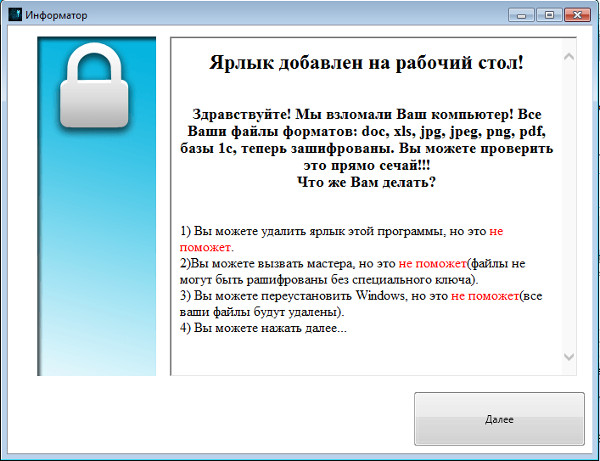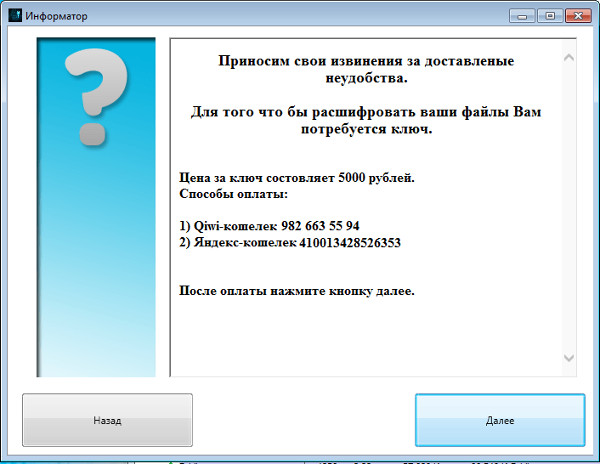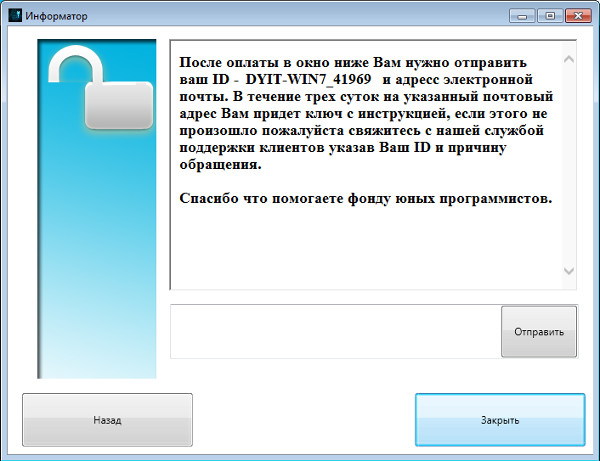RANSOM_TELECRYPT.A
W32/Crypmodadv.XCV!tr (Fortinet); Trojan-Ransom.Win32.Telecrypt.a (Kaspersky);
Windows


Threat Type: Trojan
Destructiveness: No
Encrypted: Yes
In the wild: Yes
OVERVIEW
Dropped by other malware, Downloaded from the Internet
This Trojan arrives on a system as a file dropped by other malware or as a file downloaded unknowingly by users when visiting malicious sites.
It connects to certain websites to send and receive information.
TECHNICAL DETAILS
3,227,136 bytes
EXE
Yes
10 Nov 2016
Encrypts files, Terminates processes, Drops files, Downloads files
Arrival Details
This Trojan arrives on a system as a file dropped by other malware or as a file downloaded unknowingly by users when visiting malicious sites.
Installation
This Trojan drops the following files:
- %User Temp%\keypass.Xcri - contains computer name and installation id
- %Desktop%\{Base Encrypt files-translated from Russian}.txt -contains list of files that were encrypted
(Note: %User Temp% is the user's temporary folder, where it usually is C:\Documents and Settings\{user name}\Local Settings\Temp on Windows 2000, Windows Server 2003, and Windows XP (32- and 64-bit); C:\Users\{user name}\AppData\Local\Temp on Windows Vista (32- and 64-bit), Windows 7 (32- and 64-bit), Windows 8 (32- and 64-bit), Windows 8.1 (32- and 64-bit), Windows Server 2008, and Windows Server 2012.. %Desktop% is the desktop folder, where it usually is C:\Documents and Settings\{user name}\Desktop in Windows 2000, Windows Server 2003, and Windows XP (32- and 64-bit); C:\Users\{user name}\Desktop in Windows Vista (32- and 64-bit), Windows 7 (32- and 64-bit), Windows 8 (32- and 64-bit), Windows 8.1 (32- and 64-bit), Windows Server 2008, and Windows Server 2012.)
Process Termination
This Trojan terminates the following processes if found running in the affected system's memory:
- Taskmgr.exe
Download Routine
This Trojan saves the files it downloads using the following names:
- %User Temp%\Xhelp.exe
(Note: %User Temp% is the user's temporary folder, where it usually is C:\Documents and Settings\{user name}\Local Settings\Temp on Windows 2000, Windows Server 2003, and Windows XP (32- and 64-bit); C:\Users\{user name}\AppData\Local\Temp on Windows Vista (32- and 64-bit), Windows 7 (32- and 64-bit), Windows 8 (32- and 64-bit), Windows 8.1 (32- and 64-bit), Windows Server 2008, and Windows Server 2012.)
Other Details
This Trojan connects to the following website to send and receive information:
- https://api.{BLOCKED}am.org/bot{token}/sendmessage?chat_id={chat id}&text={computer information}
It encrypts files with the following extensions:
- .doc
- .docx
- .xls
- .xlsx
- .jpg
- .jpeg
- .png
- .dbf
It does the following:
- It avoids to encrypt the following files/folders:
- Windows
- Program Files
NOTES:
It downloads a module (Xhelp.exe) with a graphical interface that shows the ransom note in Russian:



SOLUTION
9.800
12.890.02
10 Nov 2016
12.891.00
10 Nov 2016
Step 1
Before doing any scans, Windows XP, Windows Vista, and Windows 7 users must disable System Restore to allow full scanning of their computers.
Step 2
Note that not all files, folders, and registry keys and entries are installed on your computer during this malware's/spyware's/grayware's execution. This may be due to incomplete installation or other operating system conditions. If you do not find the same files/folders/registry information, please proceed to the next step.
Step 3
Restart in Safe Mode
Step 4
Search and delete this file
- %User Temp%\Xhelp.exe
- %User Temp%\keypass.Xcri
- %Desktop%\{Base Encrypt files-translated from Russian}.txt
Step 5
Restart in normal mode and scan your computer with your Trend Micro product for files detected as RANSOM_TELECRYPT.A. If the detected files have already been cleaned, deleted, or quarantined by your Trend Micro product, no further step is required. You may opt to simply delete the quarantined files. Please check this Knowledge Base page for more information.
Step 6
Restore encrypted files from backup.
Did this description help? Tell us how we did.

